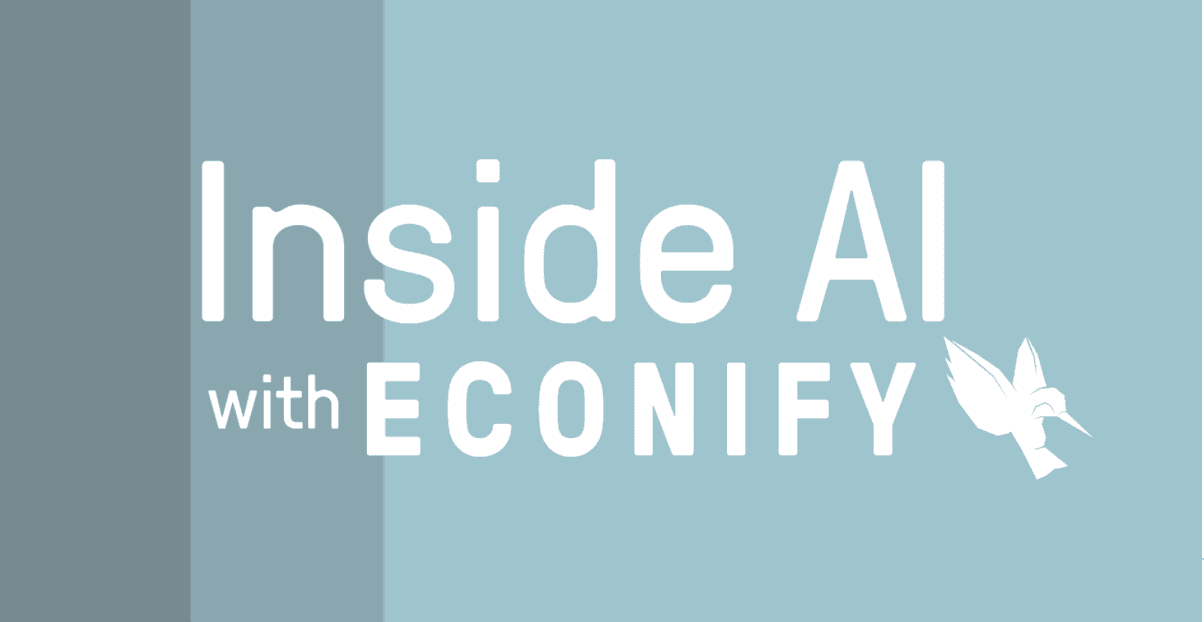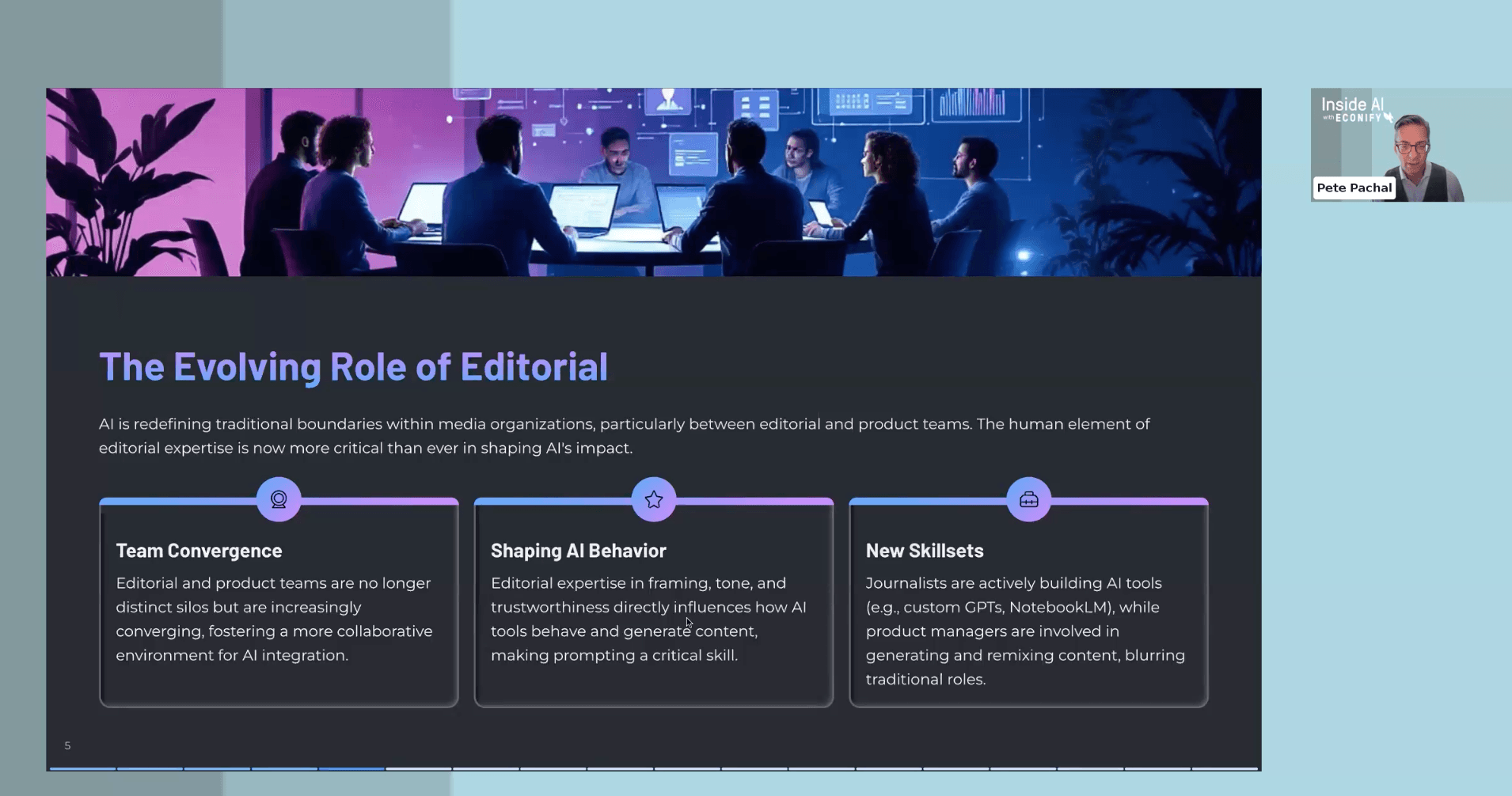Be the first to know when registration opens for the next Inside AI with Econify session.
Inside AI
How AI Is Reshaping the Media Landscape
Tue, Sep 30, 2025

AI is no longer just a story the media covers. It is fundamentally reshaping the business itself. So Econify invited Pete Pachal — a veteran journalist and founder of The Media Copilot — as guest presenter of our Inside AI With Econify webinar series to explore how AI is changing newsrooms, content strategies, and the very way audiences discover information. His views were very insightful about how the industry is being affected right now.
Depth Over Breadth: The New Currency of Media
One of Pete’s strongest messages was: shallow content won’t survive the AI era. There is clear evidence that media companies are shifting away from quick-hit, aggregated stories toward high-quality, original work that offers unique insight — the kind of analysis AI struggles to replicate. In a world where chatbots summarize everything, depth and distinctiveness are what make audiences stick around.
This isn’t just a philosophical shift. It’s a survival strategy. The metrics that matter now aren’t pageviews — they’re loyalty and engagement. This is translated into commercial strategy in that subscribers, not clickbait, are the future.

The Convergence of Editorial and Product
AI is blurring the old boundaries inside media companies. Editorial teams are learning to prompt, build lightweight AI tools, and even prototype workflows. Product teams are becoming more attuned to editorial judgment and journalistic ethics.
Pete broke this transformation into four phases:
- Skill Swap: Journalists learn prompting; PMs sharpen editorial instincts.
- Co-Design: Joint creation of AI workflows like fact-checking tools and custom GPTs.
- Hybrid Leads: New leadership roles emerge that bridge journalism and product development.
- Radical Transparency: Processes are shared openly with audiences to build trust.
The big takeaway? The newsroom of the future looks more like a lab — experimental, cross-functional, and transparent about its use of AI.
GEO: Generative Engine Optimization
If you think SEO is tough, wait until you meet its successor: GEO (Generative Engine Optimization). With ChatGPT, Perplexity, and Copilot etc. now acting as discovery engines (albeit still only accounting for around 2% of searches currently), being cited in their responses is the new way to win attention.
Here’s the playbook Pete offered:
- Be Structured & Clear: AI tools reward content that delivers clean, factual answers.
- Optimize for Citations, Not Clicks: Mentions in AI-generated answers build brand authority, even if they don’t immediately drive traffic.
- Go Multi-Engine: Don’t just optimize for Google — think about presence across multiple AI platforms.
This is a seismic shift. The “10 blue links” era of search is giving way to “winner-take-most” summaries — and media brands must adapt.
The Bot Battle and the Economics of Access
Perhaps the most provocative part of the conversation was about bots. AI crawlers are consuming vast amounts of web content, often without compensating publishers. Cloudflare, ScalePost, and others are experimenting with “pay per crawl” models, while Perplexity is piloting publisher revenue-sharing programs that could function like a “YouTube for journalism.”
This raises a difficult but exciting question: Will the web split into two? One for humans? And one for bots? This is a fascinating thought that is a real shift in strategic thinking. Media organizations will need to decide where their content lives, how to gate it, and how to monetize it. Even more than they already are!
What Media Leaders Should Do Now
Pete closed with a call to action for media professionals:
- Plan for Access Controls: Prepare your sites to handle bot traffic intelligently.
- Rethink Engagement: Build monetization models that don’t depend on clicks.
- Be Transparent: Make AI processes clear to maintain trust.
- Prototype Partnerships: Explore revenue-sharing agreements with AI platforms early.
The future of media may look very different, but it’s not all doom and gloom. There’s opportunity for those willing to innovate and to lead audiences through this transition with integrity and creativity. As always with any shift, technological or otherwise, those willing - and able - to adapt will give themselves the best opportunity to thrive in this new era.
If you would like to get access to Pete’s presentation and/or 3 month free subscription to his newsletter, get in touch here.
Pete has upcoming classes for upskilling journalists available here: